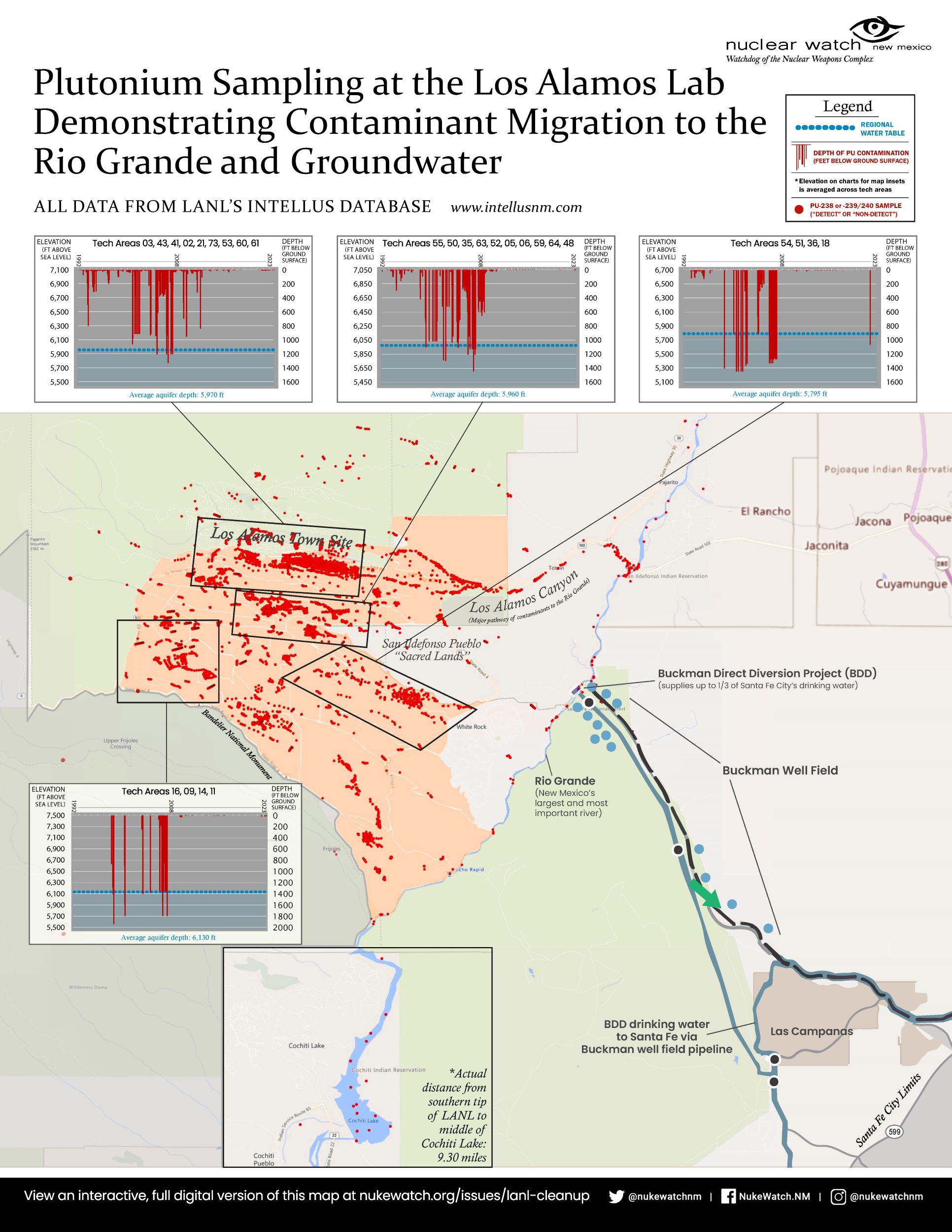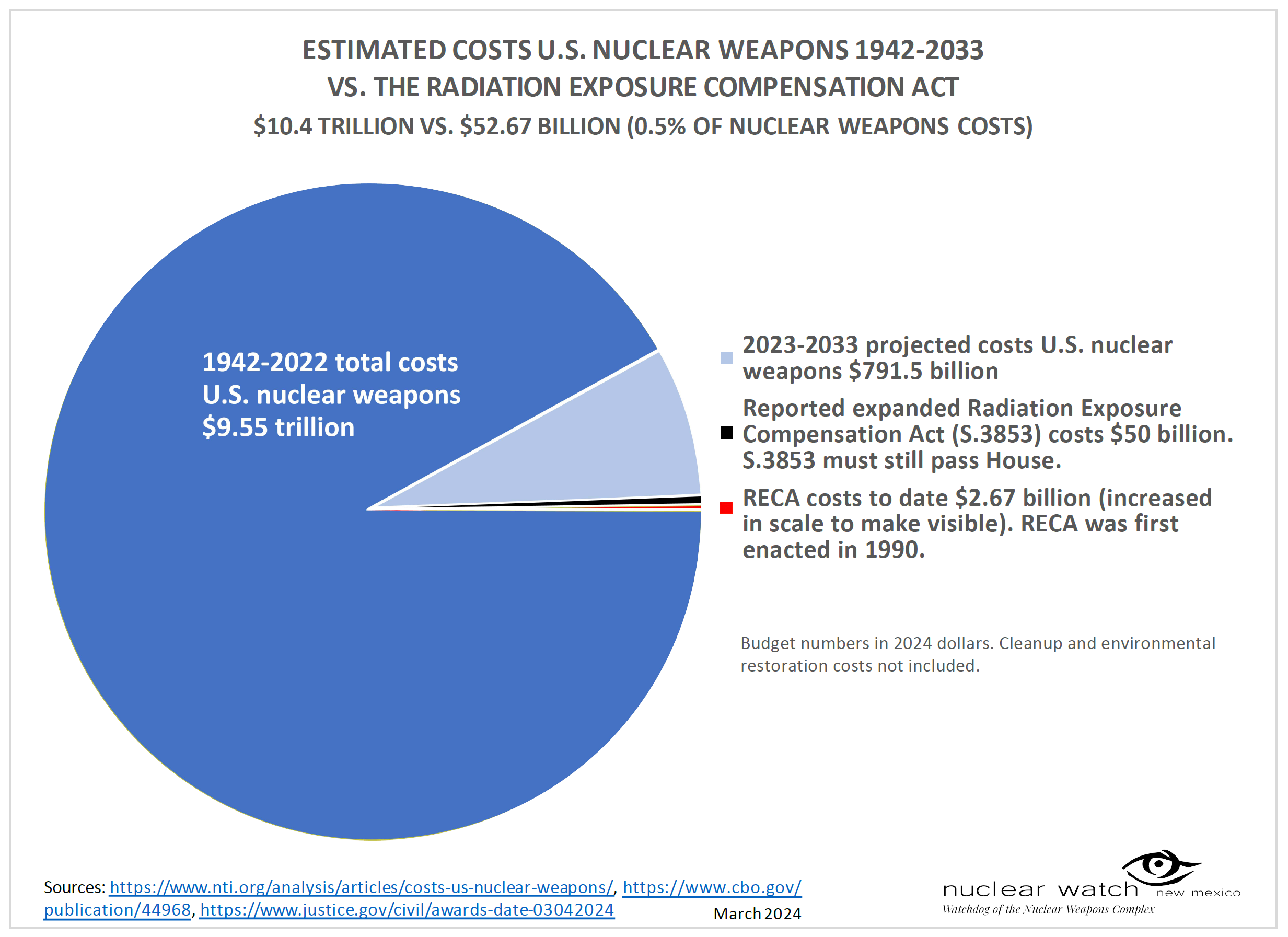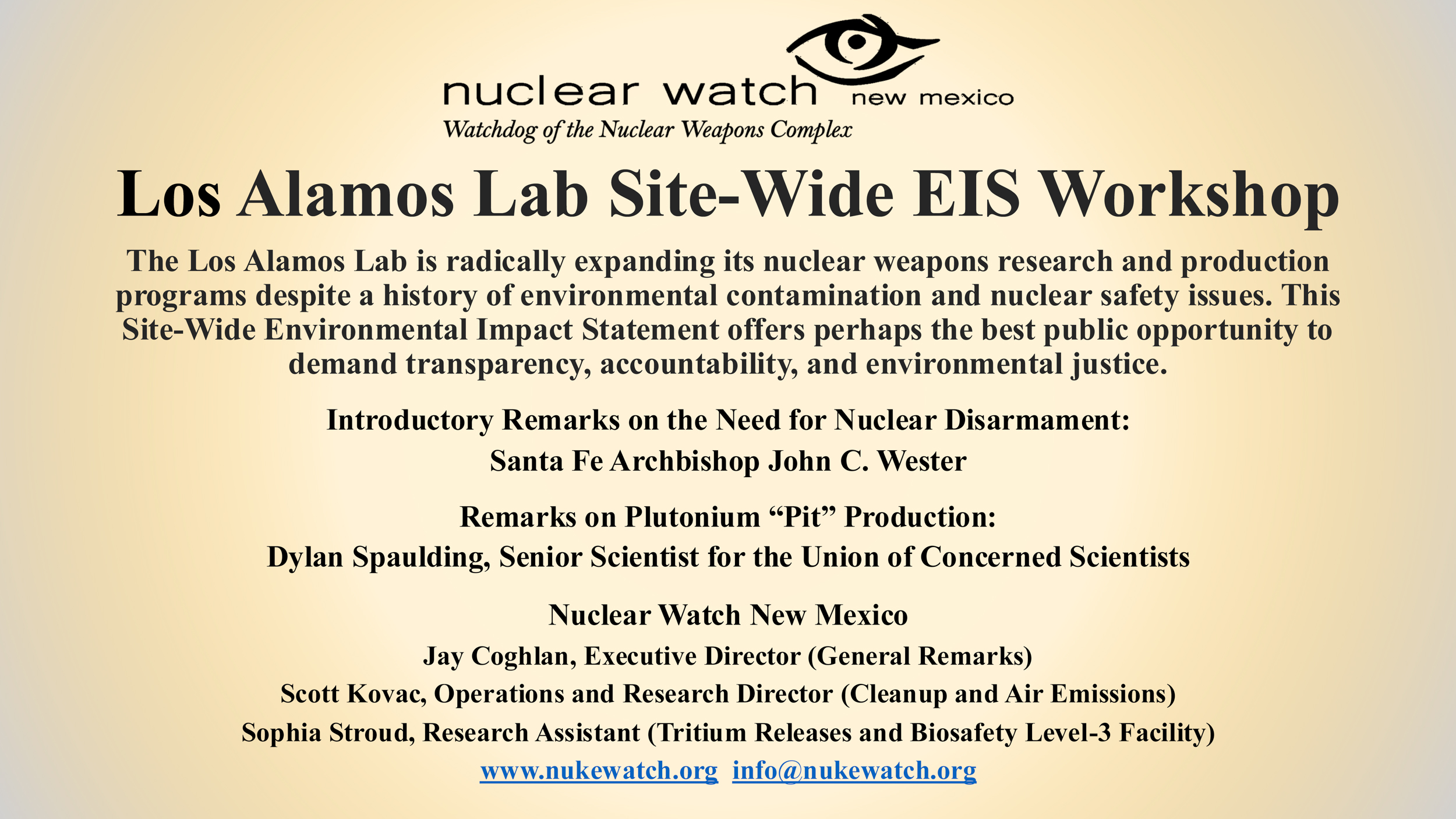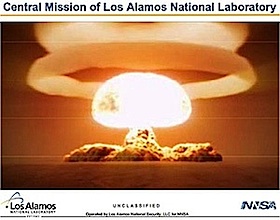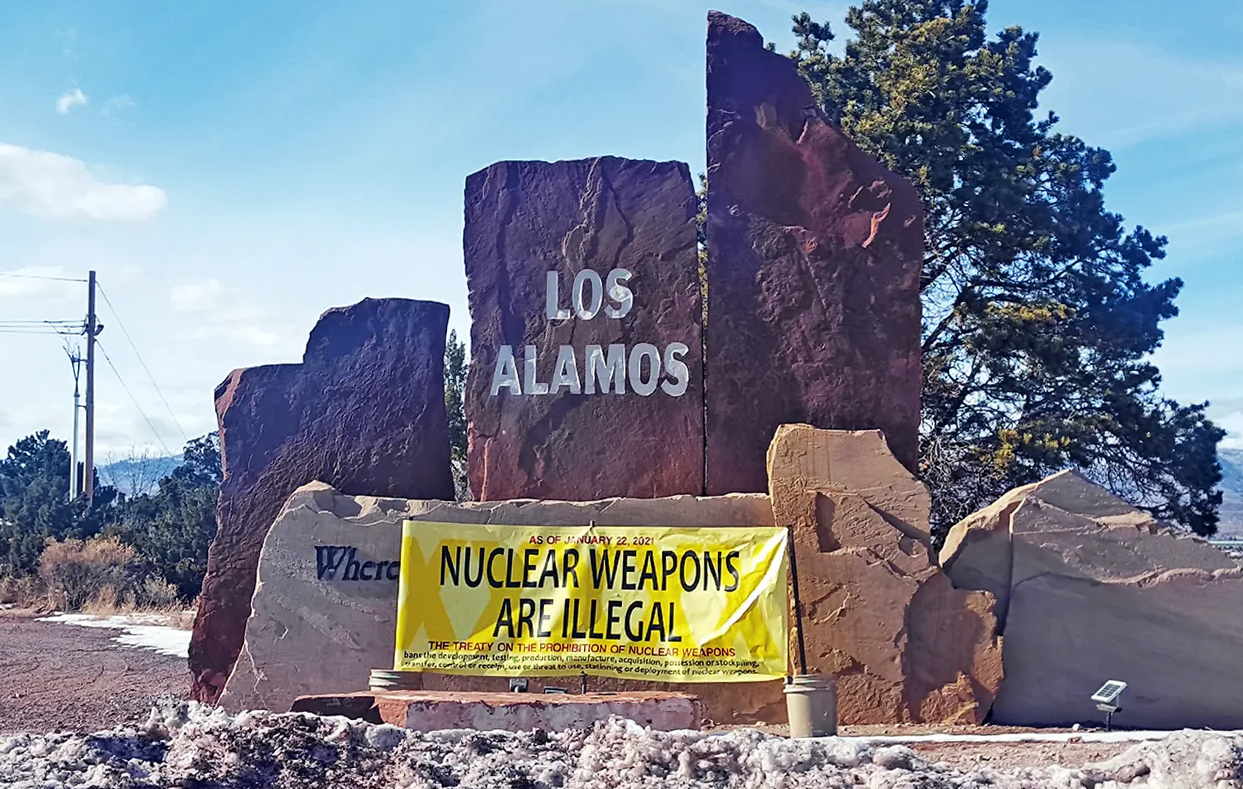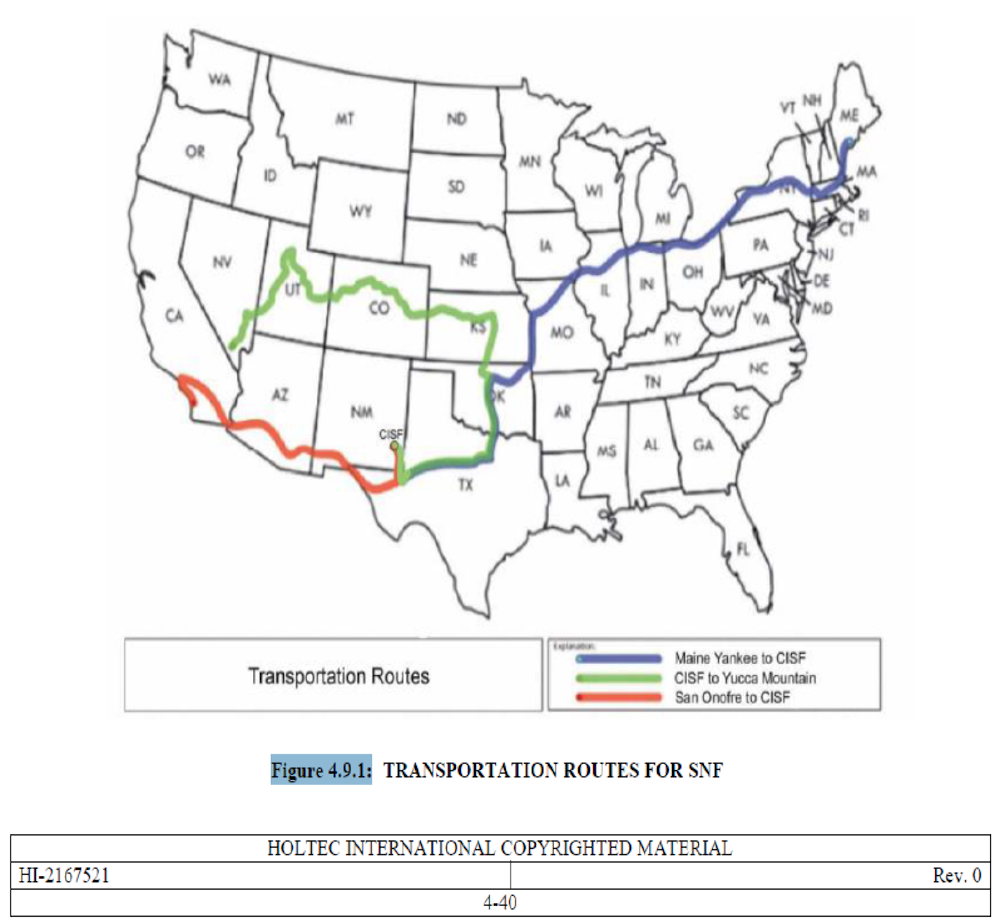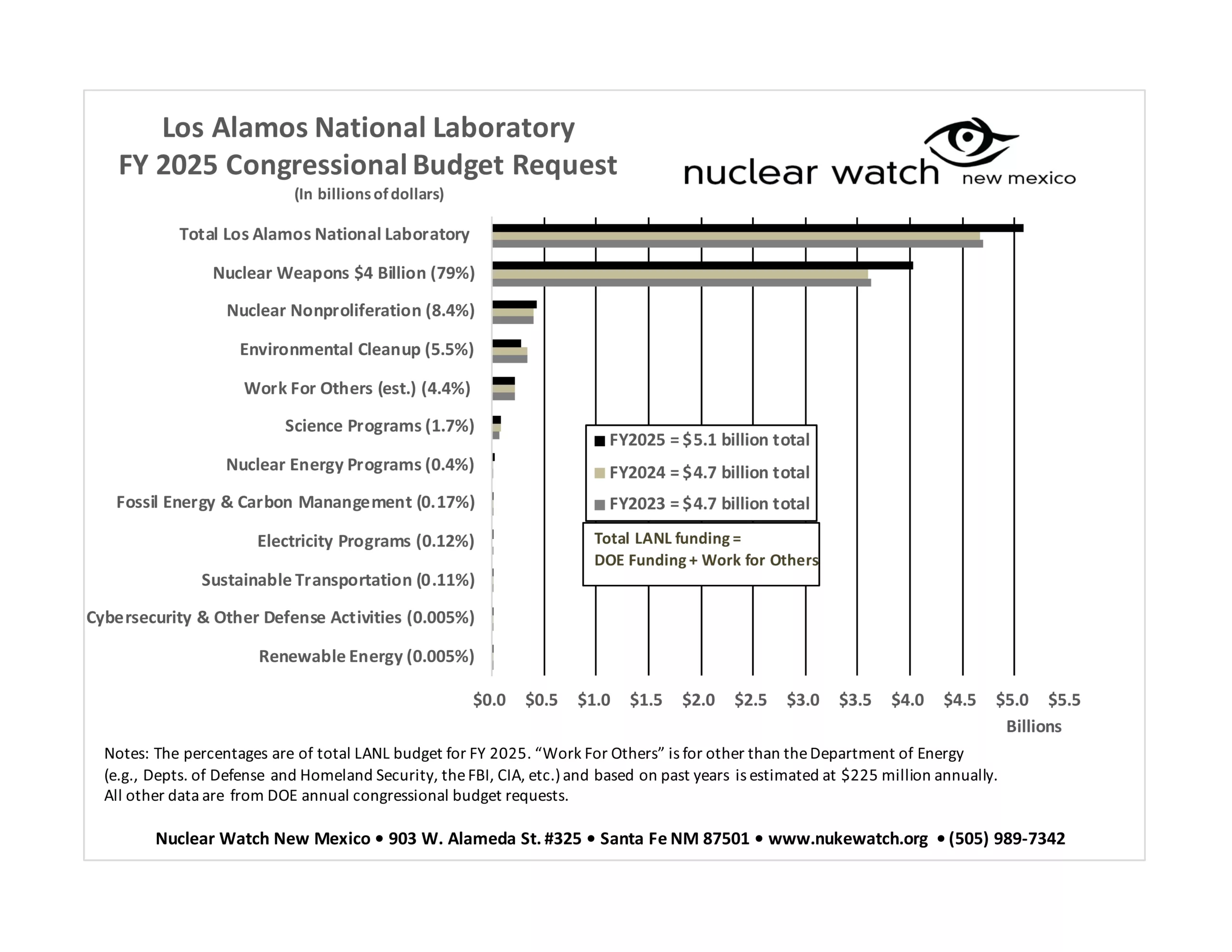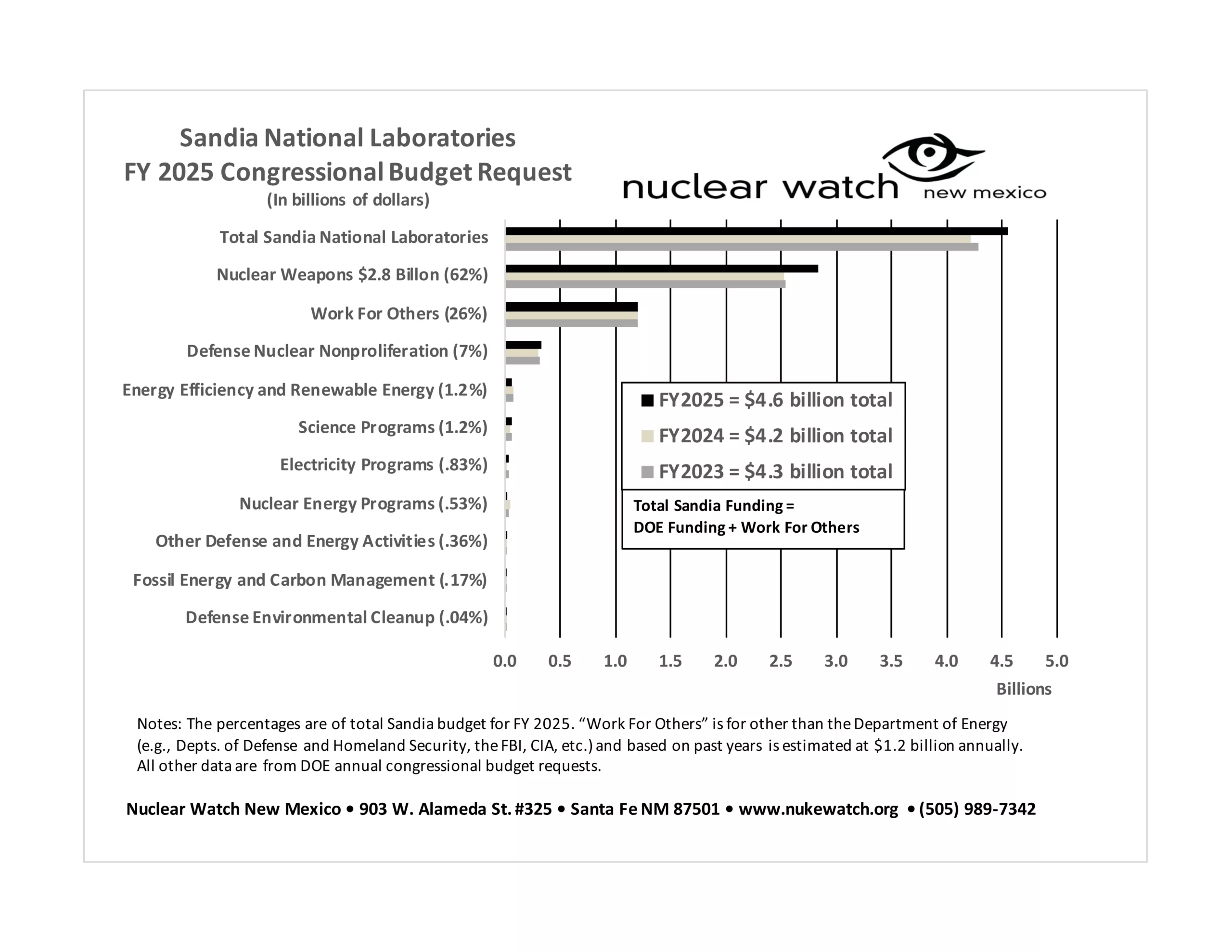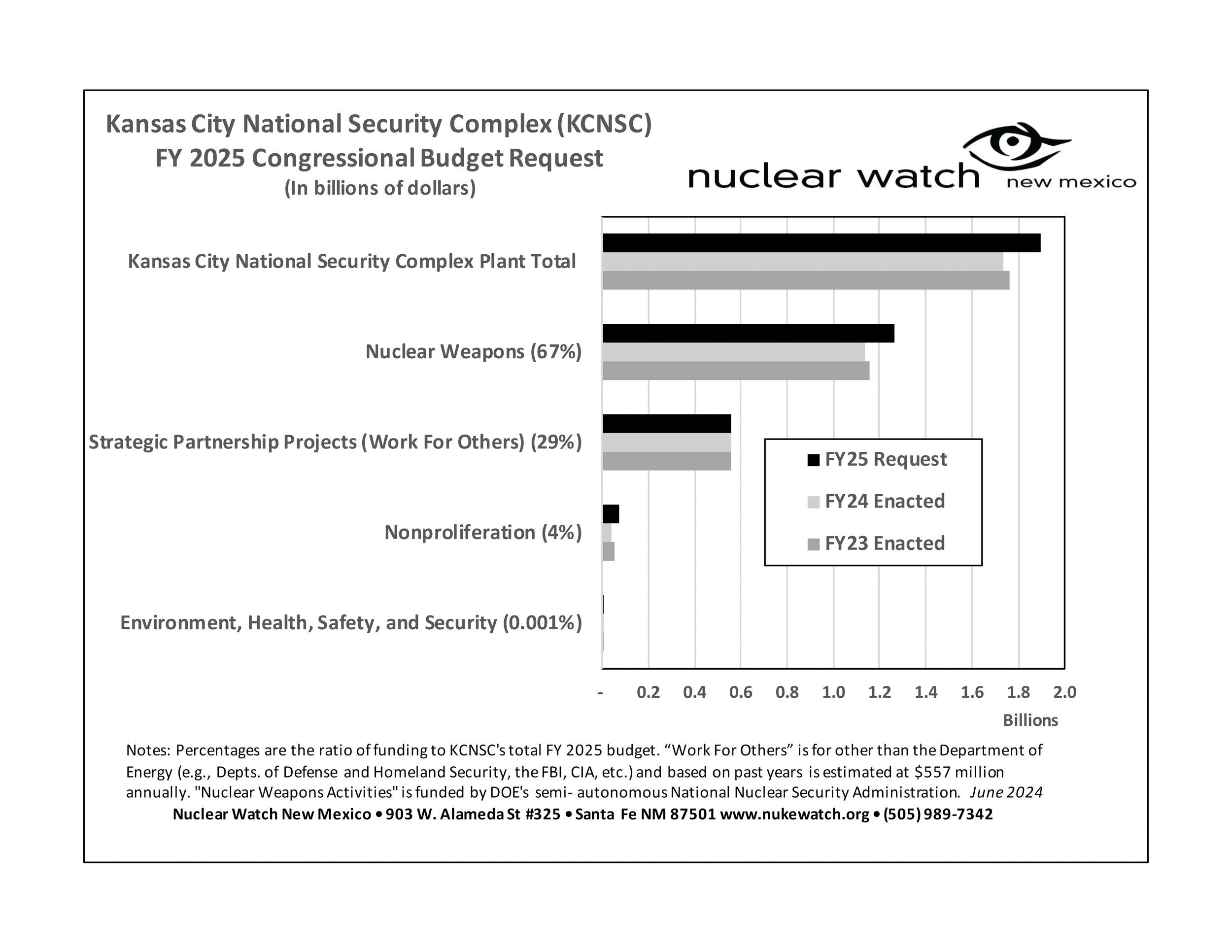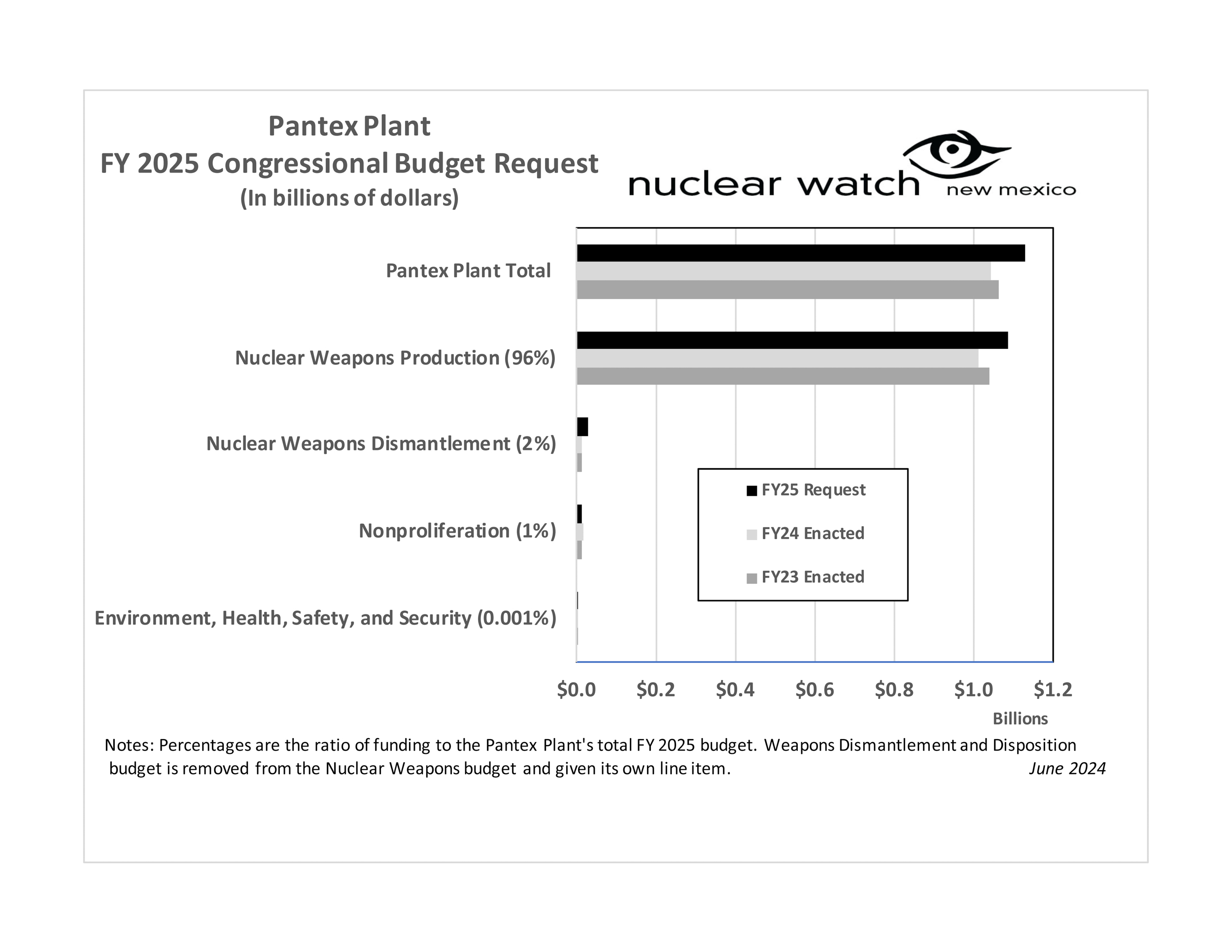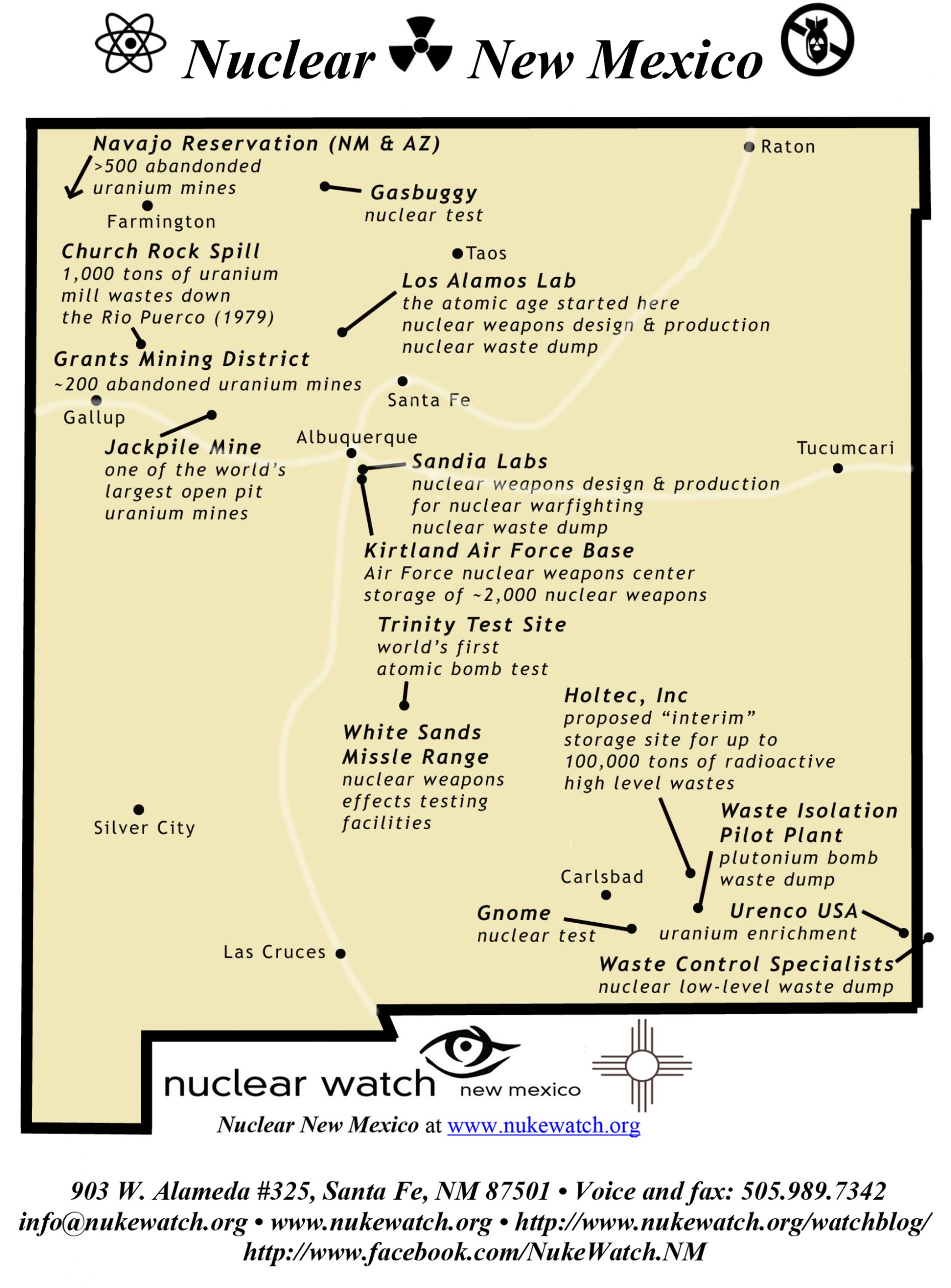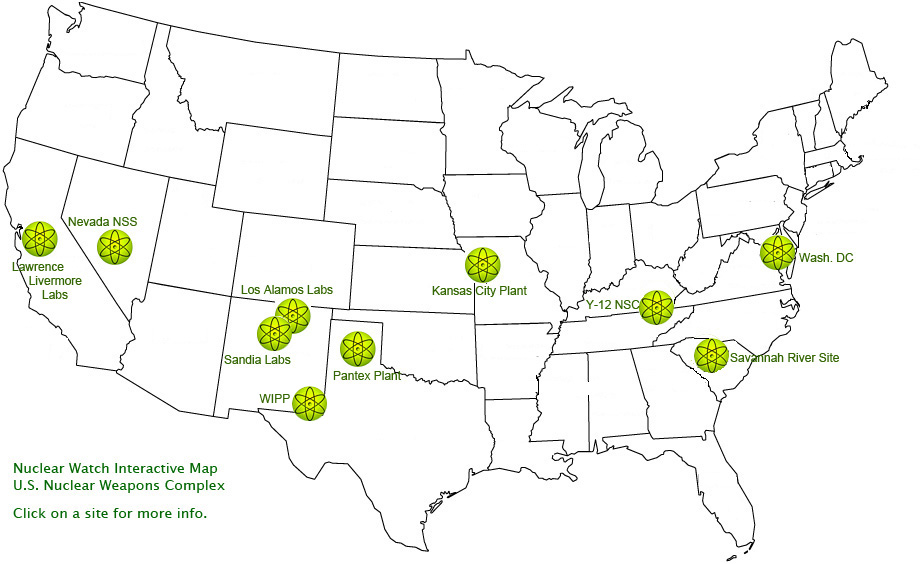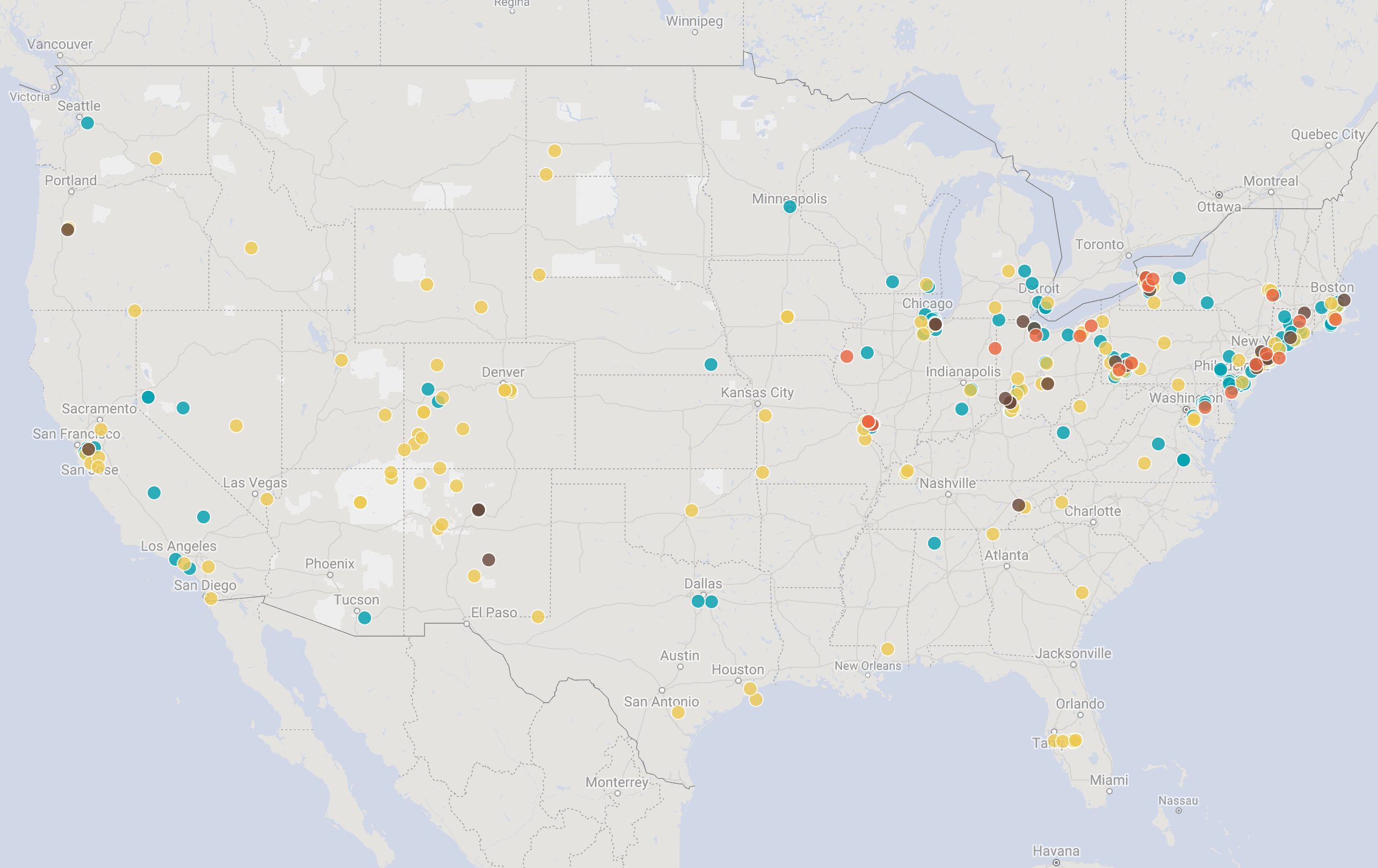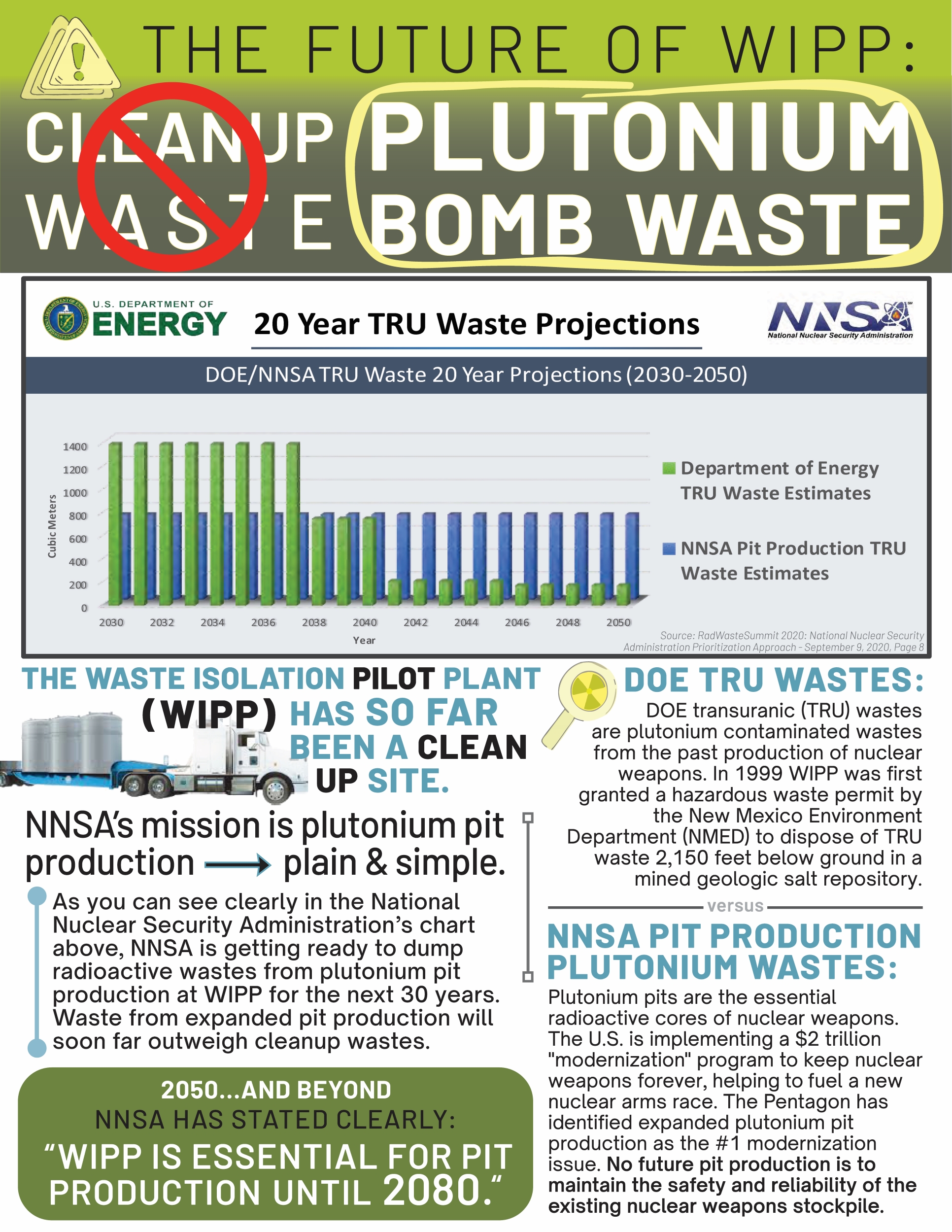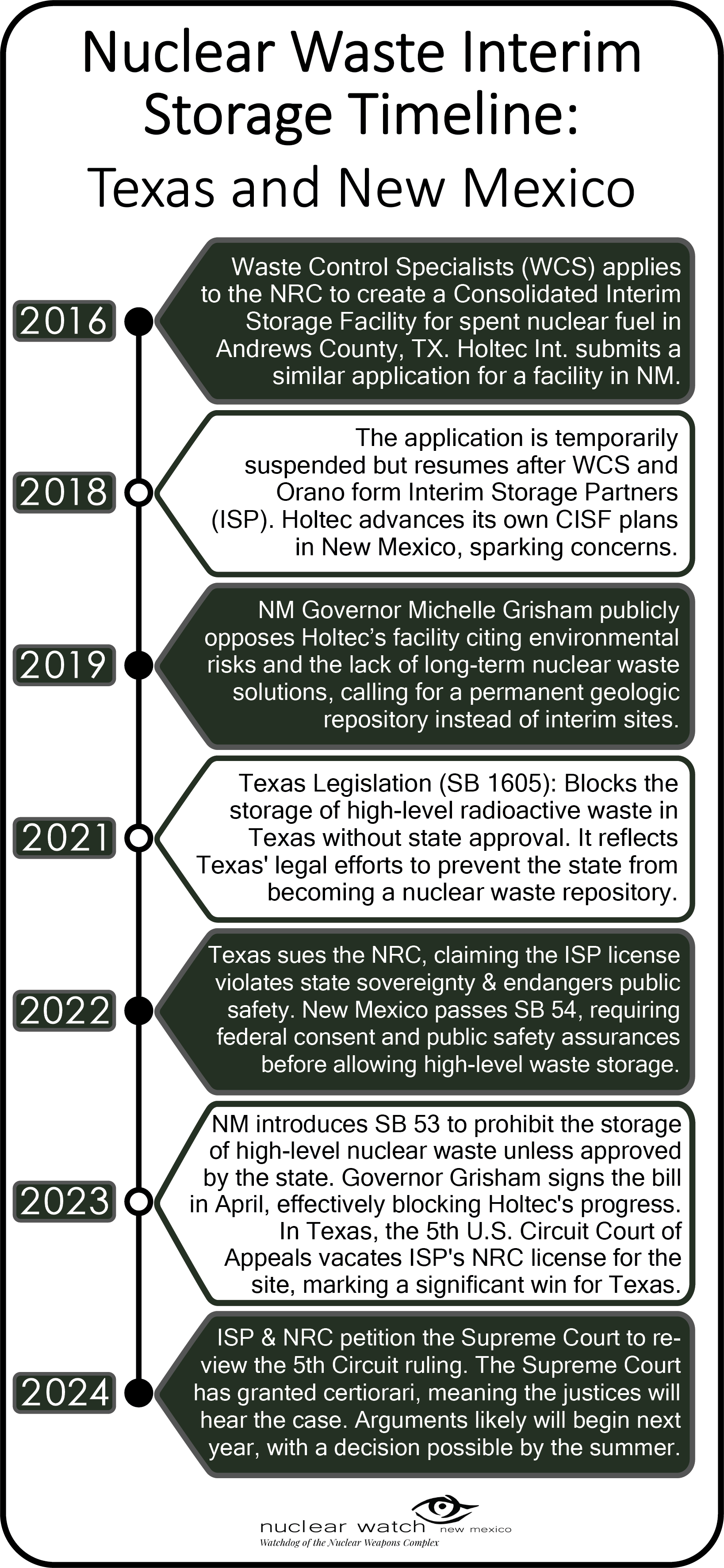QUOTE OF THE WEEK
Nothing Found
It seems we can’t find what you’re looking for. Perhaps searching can help.
LANL’s Central Mission: Los Alamos Lab officials have recently claimed that LANL has moved away from primarily nuclear weapons to “national security”, but what truly remains as the Labs central mission? Here’s the answer from one of its own documents:
LANL’s “Central Mission”- Presented at: RPI Nuclear Data 2011 Symposium for Criticality Safety and Reactor Applications (PDF) 4/27/11
Banner displaying “Nuclear Weapons Are Now Illegal” at the entrance in front of the Los Alamos National Lab to celebrate the Entry Into Force of the Nuclear Weapon Ban Treaty on January 22, 2021
Nothing Found
It seems we can’t find what you’re looking for. Perhaps searching can help.
Follow the Money!
Map of “Nuclear New Mexico”
In 1985, US President Ronald Reagan and Russian President Mikhail Gorbachev declared that “a nuclear war cannot be won and must never be fought.”
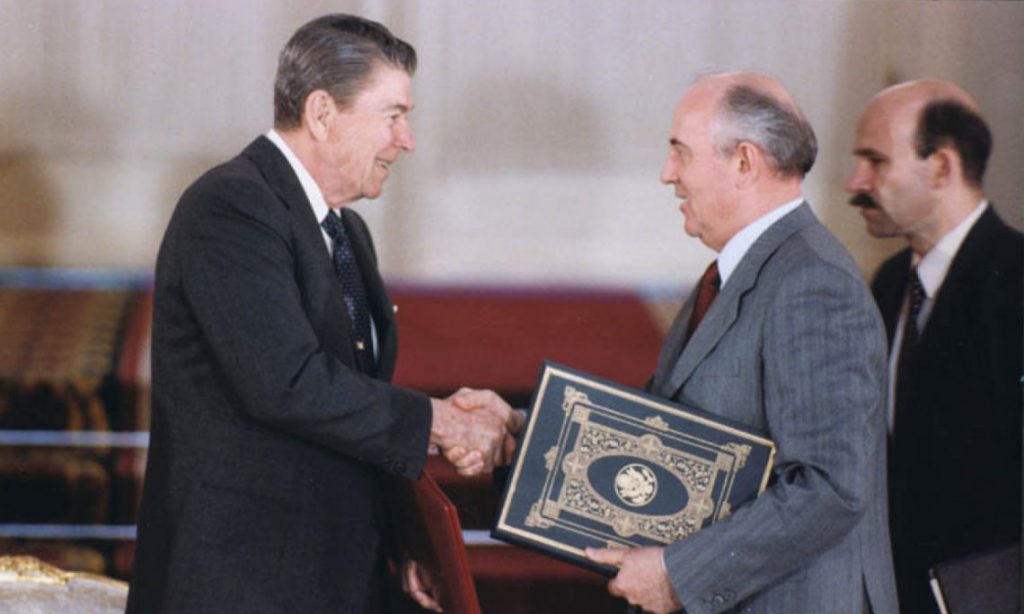
Waste Lands: America’s Forgotten Nuclear Legacy
The Wall St. Journal has compiled a searchable database of contaminated sites across the US. (view)
Related WSJ report: https://www.wsj.com
NEW & UPDATED
Watchdogs File Suit for NNSA’s Performance Evaluation Reports
FOR IMMEDIATE RELEASE, September 15, 2022 |
Jay Coghlan, 505.989.7342 jay@nukewatch.org
Santa Fe, NM – Today, Nuclear Watch New Mexico has once again filed a lawsuit to pry loose the National Nuclear Security Administration’s (NNSA’s) full and complete Performance Evaluation Reports that evaluate contractor performance at its eight nuclear weapons sites. Approximately 57,000 people are employed by NNSA’s nuclear weapons production complex, 95% of them contractor personnel. NNSA and its parent Department of Energy have been on the independent Government Accountability Office’s “High Risk List” for project mismanagement and waste of taxpayers’ dollars since 1992.
NNSA’s Performance Evaluation Reports grade contractor performance, award performance fees and contain no classified information. Nevertheless, NNSA seeks to hide how taxpayers’ money is spent from the public, issuing only terse three page summaries instead of the full and complete Reports. Nuclear Watch sued in 2012 to obtain the full and complete Performance Evaluation Reports, after which NNSA started releasing them within three working days. But NNSA has again been releasing only summaries since 2019, despite a Freedom of Information Act request by Nuclear Watch that the agency never responded to.
To illustrate the importance of these Performance Evaluation Reports, in its FY 2021 Los Alamos Lab summary NNSA noted that the contractor “[s]ucessfully made advances in pit production processes…” Plutonium “pits” are the fissile cores of nuclear weapons whose expanded production the Pentagon has identified as the number one issue in the United States’ $2 trillion nuclear weapons “modernization” program. NNSA has directed the Los Alamos National Laboratory (LANL) to begin producing at least 30 pits per year by 2026 and the Savannah River Site (SRS) in South Carolina to begin producing at least 50 pits per year by 2030.
Exchange Monitor Round-Up: Anti-nukers sue for full performance evals
By Exchange Monitor | September 15, 2022 exchangemonitor.com
In a new lawsuit, the anti-nuclear group Nuclear Watch New Mexico, Santa Fe, demanded that the National Nuclear Security Administration (NNSA) turn over “full and complete Performance Evaluation Reports” for the contractors managing the agency’s nuclear-weapon…
‘Scoping’ The New LANL Site-Wide Environmental Impact Statement
![]() BY JAY COGHLAN
BY JAY COGHLAN
Executive Director, Nuclear Watch New Mexico
‘Scoping’ The New LANL Site-Wide Environmental Impact Statement
“Scoping” means determining the issues that should be included in public analyses required by the National Environmental Policy Act (NEPA) of proposed major actions by the federal government. According to the Department of Energy ‘s own NEPA implementation regulations, DOE must prepare a new or supplemental site-wide environmental impact statement (SWEIS) for its major sites when there are “significant new circumstances or information relevant to environmental concerns.” The last site-wide EIS for the Los Alamos National Laboratory (LANL) was completed in 2008 and is badly outdated. Moreover, since 2018 the National Nuclear Security Administration (NNSA), DOE’s semi-autonomous nuclear weapons agency, has been aggressively expanding the production of plutonium “pit” bomb cores for nuclear weapons at the Lab.
Lawmakers demand reparations for New Mexicans imperiled by nuclear bomb testing
“It’s very emotional to reflect on all we’ve lost as a result of being exposed to radiation,” said consortium founder Tina Cordova, herself a survivor of thyroid cancer who said members of her family also suffered from myriad forms of the disease.
By Adrian Hedden Carlsbad Current-Argus | September 10, 2022 currentargus.com

When the U.S.’ first nuclear bomb was detonated in south-central New Mexico, it was believed to set off a chain of cancers and health problems suffered by the surrounding communities for generations.
People who grew up near the Trinity Test Site, near the remote communities of Carrizozo or Tularosa, were denied federal relief dollars afforded to other “downwinders” impacted by nuclear testing around the country.
Both towns were within 50 miles of the blast site, and advocates say they were exposed to radiation from the bomb testing.
A Guide to “Scoping” the New LANL SWEIS
“Scoping” means determining the issues that should be included in public analyses required by the National Environmental Policy Act (NEPA) of proposed major actions by the federal government. According to the Department of Energy ‘s own NEPA implementation regulations, DOE must prepare a new or supplemental site-wide environmental impact statement (SWEIS) for its major sites when there are “significant new circumstances or information relevant to environmental concerns.” The last site-wide EIS for the Los Alamos National Laboratory (LANL) was completed in 2008 and is badly outdated. Moreover, since 2018 the National Nuclear Security Administration (NNSA), DOE’s semi-autonomous nuclear weapons agency, has been aggressively expanding the production of plutonium “pit” bomb cores for nuclear weapons at the Lab.
On August 19, 2022, NNSA finally announced its intent to prepare a new LANL SWEIS, but apparently the agency will not address expanded plutonium pit production.1 NNSA’s dubious argument is that it performed the legally required NEPA analysis for expanded plutonium pit production in a 2008 Complex Transformation Programmatic Environmental Impact Statement, the 2008 LANL SWEIS and a woefully inadequate “Supplement Analysis” in 2020 that concluded a new SWEIS was not needed. 2 3
Issues That Must Be Addressed in a New LANL SWEIS
This is meant to be a guide to (or list of) the issues that must be addressed in a new draft LANL SWEIS. It is not completely exhaustive, nor is it a comprehensive fact sheet on the substance of the issues. Nuclear Watch New Mexico will offer suggested scoping comments for interested citizens and submit its own comprehensive formal comments before the October 3 deadline or extended deadline (see “Timing” below).
Agency to hold public comment on Los Alamos National Lab sitewide review
“Los Alamos lab’s plutonium modernization funding would climb to $1.56 billion from this year’s $1 billion, a more than 50 percent increase.
Jay Coghlan, executive director of Nuclear Watch New Mexico, expressed concerns about the agency indicating it saw no need to assess expanded pit production itself in the review.
“NNSA’s dubious argument is that it performed the legally required NEPA analysis for expanded plutonium pit production” in past assessments, Coghlan wrote.”
By Scott Wyland, The Santa Fe New Mexican | September 12, 2022 santafenewmexican.com
The federal agency that oversees nuclear weapons will hold two hearings this week to give the public a chance to comment about the first full sitewide environmental review of Los Alamos National Laboratory since 2008.
The National Nuclear Security Administration is conducting the sitewide review of the lab under the National Environmental Protection Act — breaking from its past resistance to doing fresh analysis of possible impacts as the lab gears up to annually produce 30 plutonium bomb pits by 2026.
Fighting rages near Russian-held nuclear plant in Ukraine
An official says the besieged Zaporizhzhia nuclear facility may be closed as residents near the plant are urged to evacuate for their own safety.
ALJAZEERA | September 9, 2022 aljazeera.com
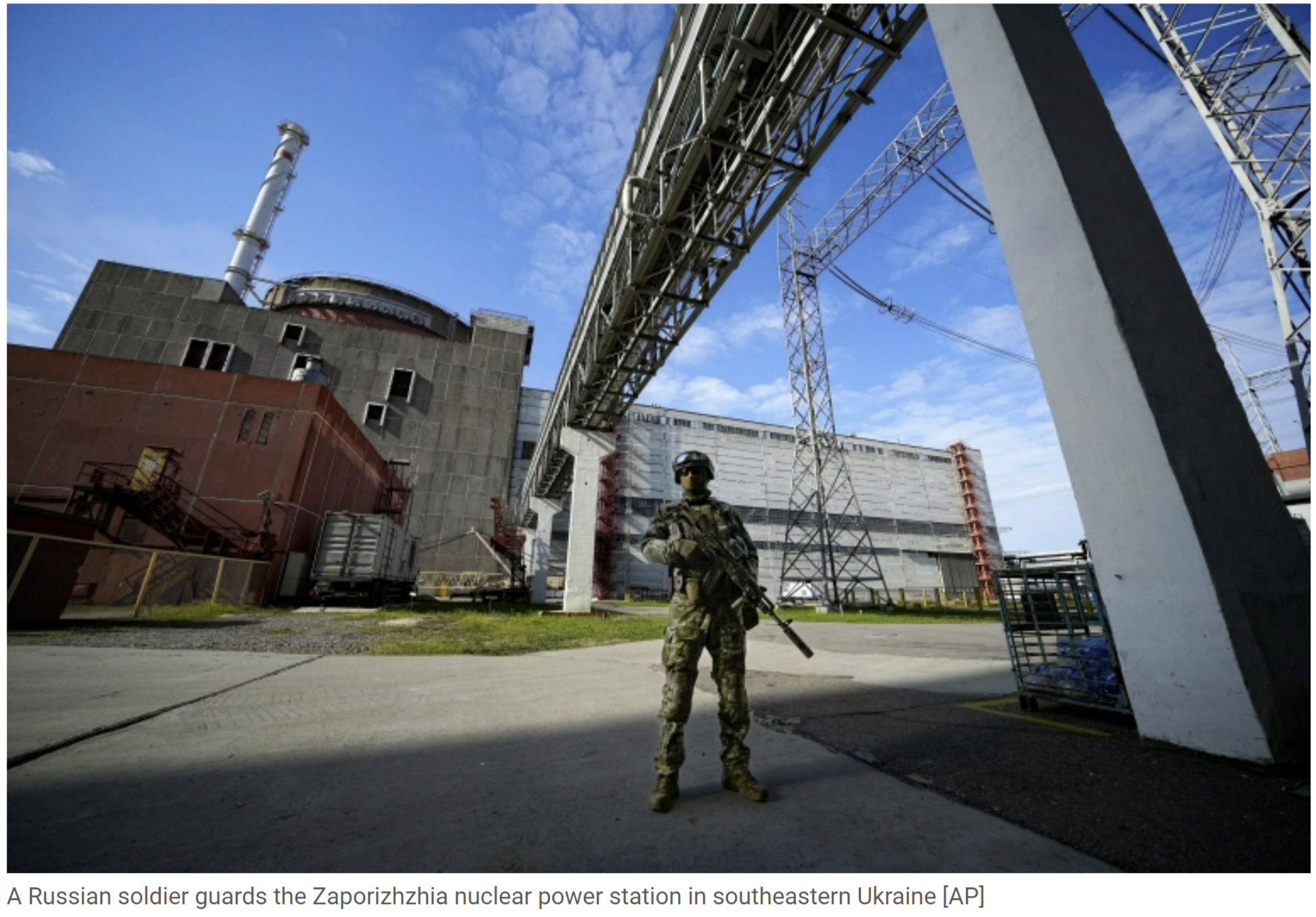 Heavy fighting erupted in areas near the Russian-occupied Zaporizhzhia nuclear power station in Ukraine after Kyiv warned it might have to shut down the plant to avoid a radiation disaster.
Heavy fighting erupted in areas near the Russian-occupied Zaporizhzhia nuclear power station in Ukraine after Kyiv warned it might have to shut down the plant to avoid a radiation disaster.
The General Staff of the Ukrainian Armed Forces said in its daily update on Thursday that some villages near the plant were bombed over the past 24 hours by “tanks, mortars, barrel and jet artillery”.
Overnight, Russian forces fired rockets and heavy artillery into the nearby town of Nikopol four times, the area’s regional governor, Valentyn Reznichenko, wrote on Telegram, damaging at least 11 houses and other buildings.
On Wednesday, an official said the nuclear plant may have to be shut down and called on residents in areas near the embattled facility to evacuate for their own safety.
SANTA FE NEW MEXICAN, MY VIEW JAY COGHLAN: LANL growth fueling new nuclear arms race
“Locally, while the lab grabs tens of billions of taxpayers’ dollars for new, counterproductive nuclear weapons production, it plans to “cap and cover” and leave buried some 200,000 cubic yards of toxic and radioactive wastes that will permanently threaten our precious water resources.”
My View Jay Coghlan – The Santa Fe New Mexican | September 10, 2022 santafenewmexican.com
The New Mexican‘s recent editorial on Los Alamos National Laboratory noted “LANL’s astounding growth” (“LANL’s growth creates pressure on safety,” Our View, Aug. 31). Cancer is defined as uncontrollable cellular growth invading other parts of the body. That is fitting here as the lab metastasizes into the city of Santa Fe (in English, “Holy Faith”). The potentially terminal disease is a second nuclear arms race. Ex-Defense Secretary Robert McNamara said we survived the first arms race only by luck.
Where is the leadership, where is the vision? While busy legislating short-term nuclear pork benefiting the already privileged, our congressional delegation leads us toward Armageddon. This second arms race is more dangerous than the first because of multiple nuclear adversaries, new cyber and hypersonic weapons, and artificial intelligence. All of this destabilizes the old Cold War architecture of mutually assured destruction (which never really went away). But “MAD” is truly insane to begin with, involving total, civilization-destroying war.
“Details of foreign country’s nuclear capabilities among documents FBI seized from Mar-a-Lago: report” “Nuclear secrets reportedly found at Mar-a-Lago are ‘gamechanger’, experts say – as it happened”
THE GUARDIAN: Report appears to confirm security officials’ worst fears about the nature of the material Trump refused to hand back
THE GUARDIAN, FOX NEWS | September 7, 2022 theguardian.com, foxnews.com
Federal agents seized the document during their search of Mar-a-Lago, the former president’s Palm Beach mansion in Florida, last month, the Washington Post reported. It appears to confirm officials’ worst fears about the nature of the intelligence he should have returned to the National Archives.
Shelling at Ukrainian nuclear plant highlights danger ahead of UN report – Reuters
U.N. seeks security zone near damaged Zaporozhzhia nuclear plant
By Pavel Polityuk and Francois Murphy, Reuters | September 6, 2022 reuters.com
Federal agents seized the document during their search of Mar-a-Lago, the former president’s Palm Beach mansion in Florida, last
KYIV/VIENNA, Sept 6 (Reuters) – Ukrainian forces shot down five Russian cruise missiles on Tuesday, most of them in the south, President Volodymyr Zelenskiy said, but he made no mention of a new military success in the east hinted at by officials earlier.
“This morning alone, five of six Russian X-101 missiles were downed,” Zelenskiy said in an evening address. “This is a costly loss for Russia, and it saves many Ukrainian lives. Four of these missiles were downed by the “South” district of the air command.”
Reuters was not able to independently verify Zelenskiy’s statement and there was no immediate response from Russia.
Though Ukrainian officials did not give specific details, several posts on social media from military bloggers and witnesses reported fighting around Balakliia, an eastern town of 27,000 people that lies between Kharkiv and Russian-held Izyum, a city with a major railway hub used by Moscow to supply its forces. One tweet by a Zelenskiy adviser spoke of “great news” coming from the president on the operation in Kharkiv region.
One Hundred and Fifteen NGOs and Individuals Ask for LANL SWEIS Comment Extension; LANL Virtual Scoping Meetings on September 13th and 14
August 31, 2022
This week 63 non-governmental organizations and 52 individuals requested that the U.S. Department of Energy (DOE) grant a two-month extension of time to provide informed public comments about the scope of the Site-Wide Environmental Impact Statement for Continued Operations of Los Alamos National Laboratory (LANL SWEIS). On August 19th, DOE announced in its Notice of Intent to Prepare a Site-Wide Environmental Impact Statement for the Los Alamos National Laboratory a 45-day comment period. Currently, comments are due on Monday, October 3rd, 2022. https://www.energy.gov/nnsa/nnsa-nepa-reading-room
 In their August 30th letter, the groups and individuals asked that the DOE Secretary Granholm and her staff extend the comment period to Monday, December 5, 2022. No response has yet been received. LANL SWEIS 2022 Scoping Extension Request 8-25-22
In their August 30th letter, the groups and individuals asked that the DOE Secretary Granholm and her staff extend the comment period to Monday, December 5, 2022. No response has yet been received. LANL SWEIS 2022 Scoping Extension Request 8-25-22
The NGOs and individuals justified their extension request by noting, among other items, that the last LANL SWEIS was finalized in 2008 – 14 years ago. Generally DOE conducts a SWEIS every 10 years. DOE proposes that this LANL SWEIS will cover “approximately the next 15 years” of operations, or to approximately 2038 and beyond.
Extension Requested For Scoping Comments Deadline For LANL Site-Wide Environmental Impact Statement
Dozens of environmental groups, non-government organizations and individuals have signed a request to the Department of Energy for a two-month extension of the Oct. 3 comment deadline for scoping comments on a Site-Wide Environmental Impact Statement for continued operations of Los Alamos National Laboratory.
BY MAIRE O’NEILL, Los Alamos Reporter | August 31, 2022 losalamosreporter.com
A letter sent Tuesday states that the current comment period is simply not enough time for the public to make meaningful comments on the scope of a proposal as large, complex and technical as the LANL SWEIS. It is addressed to Sec. of Energy Jennifer Granholm, Under Secretary for Nuclear Security Jill Hruby, DOE/NNSA Los Alamos Field Office Manager Ted Wyka and NNSA’s NEPA Compliance Officer at LANL Kristen Dors. The top two signatories are Joni Arends of Concerned Citizens for Nuclear Safety and Scott Kovac of Nuclear Watch New Mexico.
“The scope of the LANL SWEIS is of great national importance because it examines the environmental impacts associated with expanded plutonium pit production and cleanup at LANL,” the letter reads. “The 2008 LANL SWEIS is a formidable document, with 1942 pages, not counting the 144-page Summary and the 1207-page Comment Response Document. That’s a total of 3293 pages. This gives an idea of the amount of information analyses that are involved in preparing informed public scoping comments and why more time is needed.”
CRITICAL EVENTS
Nothing Found
It seems we can’t find what you’re looking for. Perhaps searching can help.
ACTION ALERTS
Nothing Found
It seems we can’t find what you’re looking for. Perhaps searching can help.
Nothing Found
It seems we can’t find what you’re looking for. Perhaps searching can help.
New Nuclear Media: Art, Films, Books & More
Nothing Found
It seems we can’t find what you’re looking for. Perhaps searching can help.
Nothing Found
It seems we can’t find what you’re looking for. Perhaps searching can help.

